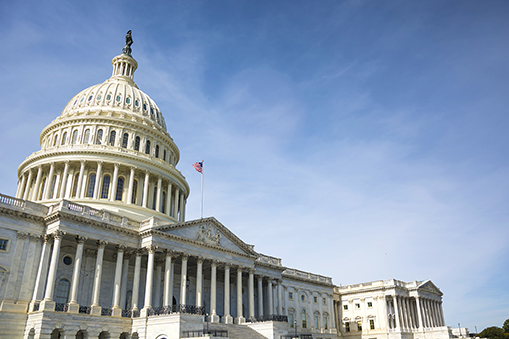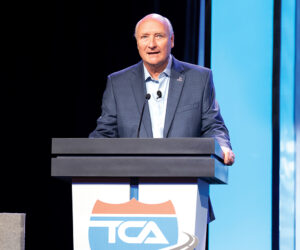Even with the nation’s capitol consumed with the COVID-19 crisis, the Washington wheels continue to turn, albeit probably more slowly than usual. The top two Capitol Recap articles report on the FMCSA sending the final hours-of-service rule to the White House for its approval and on the U.S. House considering legislation similar to the so-called California AB5 law that requires companies that hire independent contractors to reclassify them as employees, with a few exceptions.
The following articles appear as they were published in the May-June issue of Truckload Authority.
FMCSA sends HOS to OMB
The long-awaited, hoped-for revision to the hours-of-service (HOS) rule took a giant step toward reality when Federal Motor Carrier Safety Administration (FMCSA) Acting Administrator Jim Mullen announced the rule had been sent to the White House for approval.
“After carefully reviewing these comments, I am pleased to announce today that Federal Motor Carrier Safety Administration is moving forward with a final rule on hours of service and that the agency has sent a final rule to the Office of Management and Budget (OMB) for review,” Mullen said during a general session March 3 during Truckload 2020: Orlando. “While I can’t go into the specifics of this final rule, please know that the goal of this process from the beginning has been to improve safety for all motorists and to increase flexibility for commercial drivers.”
The OMB is part of the executive branch of the federal government and has the option of approving the rule or sending it back to FMCSA for changes.
There is typically a 60- to 90-day lapse between the time a rule is submitted to OMB and the time it is released as a final rule, barring, of course, any changes that might have to be made.
The comments to which Mullen referred were submitted by trucking-industry stakeholders after the agency issued an advanced notice of proposed rulemaking (ANPRM) for HOS in 2018 followed by a notice of proposed rulemaking (NPRM) in August 2019.
The ANPRM asked for comments on four areas of possible changes and the NPRM outlined five proposed changes based on the comments to the ANPRM.
The agency’s action on HOS beginning in 2018 was the result of pleas from drivers and motor-carrier executives to allow more flexibility in the rule, specifically in two areas — extending the 14-hour clock in certain circumstances and doing away with the requirement implemented in 2005 that requires eight consecutive hours in the sleeper berth.
Prior to 2005, the rule called for two periods totaling 10 or more hours in the berth, each with a minimum of two hours.
“In early March, the big news was that HOS had been sent to the OMB, but the coronavirus has changed all that,” said Truckload Carriers Association Vice President of Government Affairs David Heller. “Usually it takes 60 to 90 days for OMB to approve a final rule, but obviously things have changed dramatically and the OMB has turned to other matters.”
In the NPRM the agency proposed to:
- Increase safety and flexibility for the 30-minute break rule by tying the break requirement to eight hours of driving time without an interruption for at least 30 minutes, and allowing the break to be satisfied by a driver using on duty, not driving status, rather than off duty;
- Modify the sleeper-berth exception to allow drivers to split their required 10 hours off duty into two periods — one period of at least seven consecutive hours in the sleeper berth and the other period of not less than two consecutive hours, either off duty or in the sleeper berth. Neither period would count against the driver’s 14‑hour driving window;
- Allow one off-duty break of at least 30 minutes, but not more than three hours, that would pause a truck driver’s 14-hour driving window, provided the driver takes 10 consecutive hours off-duty at the end of the work shift;
- Modify the adverse-driving-conditions exception by extending by two hours the maximum window during which driving is permitted; and
- Change to the short-haul exception available to certain commercial drivers by lengthening the drivers’ maximum on‑duty period from 12 to 14 hours and extending the distance limit within which the driver may operate from 100 air miles to 150 air miles.
For more information about the ruling, visit truckload.org for any advancements.
U.S. House bill models California AB5 law
The U.S. House of Representatives has passed legislation similar to California’s AB5 law in that it requires employers to prove that independent contractors used in conducting business should not be classified as employees. The controversial California law, as applied to the trucking industry, is currently under an injunction imposed by a U.S. District Court judge that prohibits its enforcement.
California-based carriers, the California Trucking Association (CTA), and owner-operators doing business in the state, as well as trucking organizations on national and state levels, have all publicly opposed AB5. Industry leaders have long feared a law like AB5 would spread beyond California’s borders. With Congress considering the “Protecting the Right to Organize” (PRO) Act (HR 2474), those fears appear credible.
As widely discussed in trucking-industry circles, AB5 places the burden upon employers when classifying workers as employees or independent contractors. If a worker’s circumstances do not pass all components of a three-prong test, the individual is deemed an employee, a classification impacting company operations and the individual’s ability to choose working status. For this reason, many owner-operators who entered the business for its self-employment opportunities oppose AB5.
The federal PRO Act legislation aims to apply the same test imposed under AB5 nationwide. CTA contends that AB5 is prohibited under federal law, an argument with which the judge ruling in favor of the request for an injunction appeared to agree. With the injunction in place, the PRO Act could be considered a case of amending federal law for the purpose of allowing a state law to be enforceable.
The language in the federal act as included in Section 2(a)(2) defines an employee under the same terms as AB5. As with the California law, the sticking point relates to the (B) prong of the test. Under this prong, a company cannot hire an independent contractor to perform tasks inherent to the company’s business which other employees already perform. A carrier in the business of moving freight and employing individuals who move freight could not hire an independent contractor to perform similar tasks.
“It’s important that this legislation not move forward because it basically calls into question the entire independent contractor model our industry has been using for literally decades now,” said Truckload Carriers Association Vice President of Government Affairs David Heller. “Our understanding and hope is that the Senate will not take up the bill.”
Heller called into question what he referred to as negative press, saying while there are a few bad apples abusing the independent-contractor model, a vast majority of carriers are using the model appropriately.
“Independent contractors are independent contractors because that’s what they want to be,” added Heller.
But should the PRO Act receive U.S. Senate approval, it would be passed to President Donald Trump to either sign into law or veto. A veto seems likely as the Administration has stated the PRO Act “appears to cut and paste the core provisions of California’s controversial AB5, which severely restricts self-employment. AB5 is actively threatening the existence of both the franchise business sector and the gig economy in California. It would be a serious mistake for Congress to impose this flawed job-killing policy on the entire country.”
Truck drivers nationwide should remain in tune with further action on the PRO Act. It may impact many careers.
FMCSA’S Clearinghouse posts 650,000 registrants
The Federal Motor Carrier Safety Administration (FMCSA) released data following the first weeks of operation of its Commercial Driver’s License Drug and Alcohol Clearinghouse revealing that the clearinghouse has detected and identified nearly 8,000 positive substance-abuse tests of commercial drivers since January 6. The clearinghouse now has more than 650,000 registrants.
“We’ve seen encouraging results from the Drug and Alcohol Clearinghouse, but there’s still work to do to ensure we identify more drivers who should not be behind the wheel,” said FMCSA Acting Administrator Jim Mullen. The clearinghouse is a positive step, and the Agency continues to work closely with industry, law enforcement, and our state partners to ensure its implementation is effective.”
The clearinghouse is aimed at improving road safety by providing FMCSA and employers with the necessary tools to identify drivers who have violated federal drug-and-alcohol-testing program requirements and are prohibited from operating a commercial motor vehicle. The goal of the clearinghouse is to ensure that such drivers receive the required evaluation and treatment before they have the opportunity to resume driving.
“The numbers of positive results did not surprise me,” said Truckload Carriers Association Vice President of Government Affairs David Heller. “Over time, the clearinghouse will shake out the abusers. We have to remember that trucking is a safety-sensitive industry and is no place for substance abusers.”
Those required to register for the clearinghouse include:
- Employers of commercial driver’s license (CDL) and commercial learner’s permit (CLP) holders, or their designated service agents, and medical review officers who report drug-and-alcohol-program violations that occurred on or after Jan. 6, 2020;
- Employers or their designated service agents who conduct required queries that inform them whether prospective or current employees have drug and alcohol program violations in their clearinghouse records. Employers must purchase a query plan before conducting queries in the clearinghouse. Query plans must be purchased from the FMCSA Clearinghouse website only;
- Drivers who respond to employer consent requests or would like to view their clearinghouse record when applying for a job; and
- Substance-abuse professionals who report on the completion of driver initial assessments and driver eligibility for return-to-duty testing for violations committed on or after Jan. 6, 2020.
There is no cost for registration. Commercial drivers are not required to immediately register for the clearinghouse but will need to register to respond to an employer’s request for consent prior to a pre-employment query or other full query being conducted. In addition, employers must be registered during the first year of implementation to ensure they are able to conduct the required annual query on all employed drivers.
Combatting drug abuse has been a top priority of the U.S. Department of Transportation and the Trump Administration. President Trump has brought attention to the nation’s opioid crisis by declaring it a nationwide public health emergency and has implemented critical federal initiatives to help reduce opioid abuse.
For information about FMCSA’s clearinghouse program, including user brochures and instructional aids with step-by-step registration instructions, visit clearinghouse.fmcsa.dot.gov.
$1 trillion proposed for infrastructure budget
The 138-page proposed fiscal-year 2021 budget issued by President Donald Trump’s Administration earlier this year proposes to reauthorize surface transportation funding to the tune of $810 billion over the next decade, along with an additional one-time payment of $190 billion to support a broad mixture of “infrastructure investments” across a range of industrial sectors.
That would add up to more than $1 trillion in direct federal transportation and infrastructure funding between 2021 and 2030. This represents a “distinct departure” from the Administration’s 2018 outline, which sought to leverage $200 billion of direct federal funding into $1 trillion in overall investment with state/local and private contributions, according to an article in the Journal, the official publication of the American Association of State Highway and Transportation Officials (AASHTO).
In a related development, published reports said the Trump Administration proposed cutting billions in discretionary spending in next year’s Department of Transportation (DOT) budget, while also calling for broad increases in spending throughout the next decade, a disconnect that left some in Congress and outside groups struggling to interpret the Administration’s intentions.
As for the infrastructure proposal, the DOT said with the expiration of the Fixing America’s Surface Transportation (FAST) Act in September, the time to take bold action to address these and other challenges is now.
“Building on the foundation provided in the FAST Act, the Administration’s funding proposal would largely grow by almost 4% annually through fiscal year [FY] 2030 … that will provide states and other entities with dependable and predictable funding for an entire decade,” a DOT spokesperson said.
Near term, that translates into an $89 billion budget request for DOT FY 2021 funding — a nearly 2% increase above FY 2020 appropriations, of which $64 billion would come via the Highway Trust Fund (HTF). The Administration noted, however, that its request for $21.6 billion in discretionary transportation budget authority for FY 2021 is a $3.2 billion, or 13%, decrease from what was enacted for FY 2020.
An analysis of the budget proposal by AASHTO policy staff noted that such fiscal proposals by the White House represent “the traditional first step” in budget negotiations with Congress toward final FY 2021 appropriations measures.
The proposed DOT FY 2021 budget cuts discretionary spending by 13%, including deep reductions in spending on Amtrak and airport grants. It also cuts more than $2 billion in highway infrastructure funds.
DOT’s Acting Undersecretary Joel Szabat pointed to the deep shortfall in the HTF, which covers road and transit projects nationwide.
The HTF’s main source of revenue, the gas tax, has failed to keep up with inflation or national needs.
As it always has been, the argument over whether to raise the gas tax to replenish the HTF remains a major sticking point in the discussion about how to fund any infrastructure plan.
Tolls and a vehicle-miles-traveled tax are other funding options that have been discussed within the circle of transportation stakeholders.
“We estimate that there’s $261 billion in additional Highway Trust Fund cash that’s required to support the Administration’s proposal over 10 years,” shared Szabat.
Lower registration fees
As of Feb. 13, motor carriers will now see a reduction in the price they must pay to register their vehicles.
The Federal Motor Carrier Safety Administration (FMCSA) released a final rule that realigns the fees for the Unified Carrier Registration Plan.
According to the document posted on the Federal Register, the rule establishes reductions in the annual registration fees the states collect from motor carriers, motor private carriers of property, brokers, freight forwarders, and leasing companies for the UCR Plan and Agreement for the registration years beginning in 2020.
“For the 2020 registration year, the fees will be reduced by 14.45% below the 2018 registration fee level to ensure that fee revenues collected do not exceed the statutory maximum, and to account for the excess funds held in the depository,” the document reads. “The fees will remain at the same level for 2021 and subsequent years unless revised in the future.”
The reduction of the current 2019 registration year fees range from approximately $3 to $2,712 per entity, depending on the number of vehicles owned or operated by the affected entities.
The UCR Plan and the 41 states participating in the UCR Agreement establish and collect fees from motor carriers, motor private carriers of property, brokers, freight forwarders, and leasing companies. The UCR Plan and Agreement are administered by a 15-member board of directors; 14 appointed from the participating states and the industry, plus FMCSA’s Deputy Administrator or another presidential appointee from the Agency, according to the final rule.
Revenues collected are allocated to the participating states and the UCR Plan. If annual revenue collections exceed the statutory maximum allowed, then the Plan must request adjustments to the fees. In addition, any excess funds held by the Plan after payments are made to the states and for administrative costs are retained in a UCR depository, and fees subsequently charged must be adjusted further to return the excess revenues held in the depository.
Adjustments in the fees are requested by the Plan and approved by FMCSA. These two provisions are the reasons for the two-stage adjustment adopted in this final rule.
“While each motor carrier will realize a reduced burden, fees are considered by the Office of Management and Budget (OMB) Circular A–4, Regulatory Analysis as transfer payments, not costs. Transfer payments are payments from one group to another that do not affect total resources available to society. Therefore, transfers are not considered in the monetization of societal costs and benefits of rulemakings,” according to the document.
The rule states that the total state revenue target is more than $107 million.
For more information or to read the rule in its entirety, visit fmcsa.dot.gov/regulations/rulemaking/2020-01761.
Lyndon Finney’s publishing career spans over 55 years beginning with a reporter position with the Southwest Times Record in Fort Smith, Arkansas, in 1965. Since then he’s been a newspaper editor at the Southwest Times Record, served five years as assistant managing editor of the Arkansas Democrat-Gazette in Little Rock and from November 2004 through December 2019 served as editor of The Trucker. Between newspaper jobs he spent 14 years as director of communications at Baptist Health, Arkansas’ largest healthcare system. In addition to his publishing career he served for 46 years as organist at Little Rock’s largest Baptist church.














